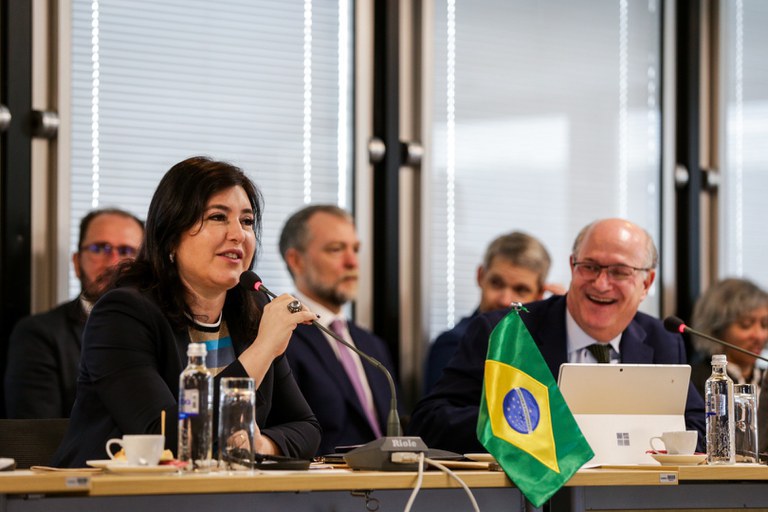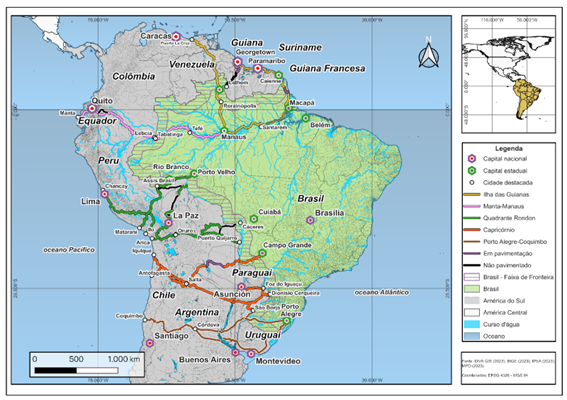Advanced cookie settings
To improve your experience on the platform and provide personalized services, we use cookies.
Notícias
NEW PAC

Crédito: João Pedro Orban
The Minister for Planning and Budget (Ministério de Planejamento e Orçamento - MPO), Simone Tebet, the Secretary for Institutional Articulation, João Villaverde, and the Secretary for International Affairs and Development, Renata Amaral, presented the "Integration PAC" -Growth Acceleration Program for Integration- on Friday (8/12) to ministers or representatives from ten South American countries - Argentina, Bolivia, Chile, Colombia, Ecuador, Guyana, Paraguay, Peru, Uruguay and Venezuela.
Also present were the director of the BNDES, Nelson Barbosa, and the presidents of the Inter-American Development Bank (IDB), Ilan Goldfajn; CAF - Development Bank of Latin America and the Caribbean, Sérgio Diaz-Granados; and the president of Fonplata, Luciana Botafogo.
Tebet affirmed that there are 12 countries involved in the Integration PAC, which allows us to once again talk about regional integration, but without losing sight of the Brazilian authorities in the border states and cities. "When we talk about regional integration, we're talking about reducing distances. We want to bring people together. We take into account cultural, economic and digital integration. Its implementation is open to construction and collaboration," she said.
Tebet and the Secretary for Institutional Articulation, João Villaverde, presented the participants with the results of the work of the Subcommittee for South American Integration and Development which, after more than 20 meetings with other ministries, state governments and government bodies, mapped out five integration routes. In Brazil, these are constituted by more than 100 works that are already in the New PAC and therefore foreseen in the budget for the coming years.
"Integration is something we practically have to do. Based on this prerogative, and more than 20 meetings, we have designed these five proposed routes. They aim to contemplate a South American integration proposed from Brazil and from three main axes: active listening, which begins with the authorities of the eleven Brazilian states that border neighboring countries; a curation of PAC works that had to do with this integration that located 124 multifaceted works; and the guarantee of maintaining dialogue," said Villaverde.
"The routes started out as a dream, but they are not a utopia. With this mapping, we have the information that can make this dream come true. We are at the disposal of our partner countries and we have the partnership of financial institutions. In addition, we have new resources, financing made available to the countries of South America. We know that these countries must and can become competitive in the world," said the minister.
Tebet reiterated that regional integration is a priority not only for the federal government, but also for state governments, especially those on the border. The integration routes, she defended, are not just to reduce the time it takes to transport goods between Brazil and Asian markets, but to strengthen ties with neighboring nations, allowing for more growth, generating jobs and income for the population.
To exemplify the anomalies that currently mark the movement of goods between South American countries, Tebet spoke of the olives imported from Peru through Rondônia. "These olives go around the Panama Canal until they reach the Port of Santos, and travel 3,000 kilometers by land until they arrive in Rondônia. Rondônia borders Peru and is only 2,000 kilometers from Tacna, where Peru's largest olive production is located," she reported.
US$ 10 billion for integration
Remembering that in the past, the IDB, CAF and Fonplata played an important role as the technical secretariat for South American integration processes, the minister welcomed the initiative announced on Thursday by the four institutions to contribute resources to integration projects. "It is a considerable resource, we are talking about US$ 10 billion, around BRL 50 billion," said the minister, highlighting that this is completely new money.
She pondered that all countries have "a responsibility to guide the actions of regional development banks" so that this project reaches its full potential. In this sense, she suggested a network of South American development bank governors with a focus on integration.
"The commitment to send US$ 10 billion dollars to the region is a historic mark and represents only the beginning of a work to identify and solve the bottlenecks that challenge the integration of South America," said the MPO's Secretary for International and Development Issues, Renata Amaral.
"We have been talking about this integration for 30 years, and now it is time to act. We also see here a big opportunity to bring the private sector and its resources from the projects we have and also from other sovereign countries that are interested in investing in the region," affirmed the president of CAF, Sergio Diaz-Granados.
"Yesterday we improved our tomorrow. We are talking about integration in the sense of routes, but also physical, digital, fluvial, commercial, electrical. And in the end, all of this is dedicated to getting closer to improving lives," said IDB President Ilan Goldfajn. "We will be focused on results, but results that are environmentally sustainable," he added. "We must not ignore the need to revitalize coordinating institutions, because some resources already exist today and sometimes, they do not reach where they could. The routes can provide objectivity and a line that will direct these resources," said Luciana Botafogo, Fonplata's president.
Background and context of the five South American integration routes and the work of the Subcommittee
On May 30, President Luiz Inácio Lula da Silva and 11 South American leaders established the Brasilia Consensus, in which they reaffirmed the need to revitalize regional integration. Following this meeting and in response to President Lula's request, the Minister of Planning and Budget, Simone Tebet, created the Subcommittee on South American Integration and Development within the MPO.
Since then, the subcommittee has dedicated itself to an intense work of listening to ministries, federal government bodies and the 11 border States. More than 20 meetings were held. At the meetings with the 11 States, information was collected on the projects they consider to be priorities for integrating infrastructure with their neighbors. Based on these criteria, of the more than 9,000 projects in the New PAC, around 115 were selected with the potential to contribute to regional integration. Placed on the map, they gave origin to five integration routes:
1) The Guiana Island Route, which includes the entire states of Amapá and Roraima and parts of the territory of Amazonas and Pará, linked to Guiana, French Guiana, Suriname and Venezuela;
2) The Manta-Manaus Multimodal Route, covering the entire state of Amazonas and parts of the territories of Roraima, Pará and Amapá (in Brazil), interconnected via river to Colombia, Peru and Ecuador;
3) Route of the Rondon Quadrant, formed by the states of Acre and Rondônia and the entire western portion of Mato Grosso (in Brazil), connected to Bolivia and Peru;
4) The Capricorn Route, from the states of Mato Grosso do Sul, Paraná and Santa Catarina (in Brazil), linked by multiple routes to Paraguay, Argentina and Chile; and
5) Porto Alegre-Coquimbo route, covering Rio Grande do Sul (in Brazil), integrated with Argentina, Uruguay and Chile.

The opening of new integration routes would not only strengthen Brazil's trade with its neighbors, but also sensitively reduce trade time with Asia, especially for agricultural production in the Midwest and the Brazilian North. In the last few years, although Brazil's trade with the world has intensified and diversified compared to the 2000s, the routes for transporting production and internalizing imported products have changed little.
Although South America has lost relative weight in Brazilian foreign trade as a result of the growth in exports and imports with China, 85% of Brazilian export sales to South America are industrial goods. And our South American neighbors are responsible for 35% of all foreign sales of high and medium-high technological intensity.
